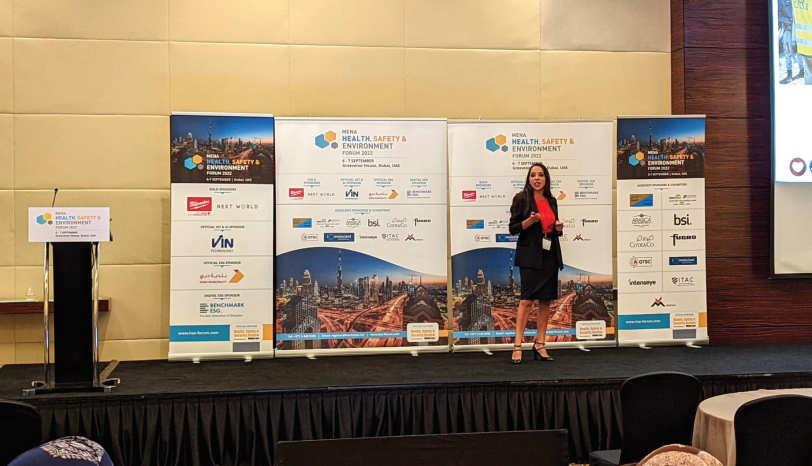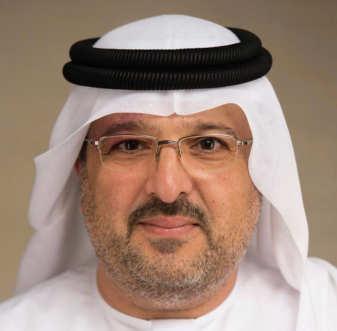
13 minute read
MENA HSE Forum
Coming together to advance HSE
The MENA HSE Forum, which took place on 6-7 September at the Grosvenor House, Dubai, was a resounding success.
ABOVE: More than 150 delegates from the regional HSE community attended the event. The event delivered a well structured programme combining presentations and panel discussions to more than 150 delegates from the HSE community of the UAE, Saudi Arabia, Qatar, Oman and Bahrain. Senior HSE practitioners from the region’s leading companies, including ADNOC, Petrofac, Dubai Municipality, EGA, Saudi Aramco, Drydocks World, Abu Dhabi Waste Management Centre – Tadweer, Be’ah and Dubai Holding came together to discuss current developments, share experiences and best practices as well as access the latest innovations to advance HSE.
“It has been our constant endeavour to create platforms which ensure value addition for all stakeholders in the region. The MENA HSE Forum this year was the culmination of over 20 weeks of work. Stakeholders from major industries identified the need for new technologies that will continue to cut LTI and optimise productivity. Our research also identified a need to access the latest safety solutions for the workforce across the board, which led us to create this exclusive platform for HSE companies to display and demonstrate their services and solutions to key players in the region. Our efforts to ensure that this edition is of its highest quality has paid-off,” said Vinay T, head of business development at Alain Charles Events, the organisers of the Forum.
The programme commenced by exploring various aspects of safety management, including presentations by Saleh Albalushi, head of HSE, Drydocks World, on building shared commitment for safety within an organisation, and on achieving sustainable results through HSE culture
transformation strategy by Sultan Karrani, senior engineer - HSE, ADNOC.
To help organisations strategise on occupational safety standards, Eng Mohamed Abdula Almarzooqi, head of Accident Investigation Team - Health & Safety Department, Dubai Municipality, outlined the most common causes of accidents in Dubai industrial sectors, revealing that falls from height accounted for nearly 38% of the accidents in Dubai. The audience also gained access to a case study on the crisis management planning and mitigation strategies adopted by DAMAC Properties that led to optimal recovery from the pandemic.
The panel discussion on Day 1 further examined crisis and business continuity management through a debate on the need for agility and flexibility while having a structured approach in place, supported by clear strategies for communication and escalation in times of crisis.
Digital transformation in focus
Digital transformation in the HSE sector was a key area of focus at the Forum, with discussions and presentations continuing into the second day. Lynn Hoballah, head of health & safety, Petrofac, demonstrated how her organisation is making use of social media and gamification for greater employee engagement. The impact of disruptive technologies in solving HSE requirements was further debated by a panel that examined how these can be used to improve HSE operational efficiency and help in mitigating risks.
Lessons on occupational health and behavioural safety during the pandemic were addressed by Dipl Ing Peter Michael Hamel, department head OHSE, Be’ah, quoting from his experiences in Oman during the lockdown.
The HSE Forum's focus on sustainability and the environment included diverse perspectives such as the value that ESG is creating in the aluminium industry. An update by the Dubai Municipality, delivered by Dr Jasminka Jaksic, senior environmental specialist, gave the audience an insight into how the Dubai Municipality monitors conformance to air quality regulations. Dubai Municipality's interactive display on air quality at the HSE Forum's Technology Showcase Hall invited the attention of delegates.
MILWAUKEE, a gold sponsor of the event, showcased its range of power tools, combining innovation with cutting-edge battery technology, providing solutions for diverse trades and applications.
Another gold sponsor, Next World, is a provider of VR training. Their VR Learning Management System (LMS) helps effectively induct, train and upskill employees through immersive VR training experiences.
The digital sponsors of the Forum included Benchmark ESG, which enables companies to implement Environmental, Social and Governance (ESG) solutions through its software suite for ESG reporting, sustainability and operational compliance; Intenseye, offering AI solutions for increased workplace safety as well as iOmniscient, providing AI -based multi-sensor analytics for health, safety and security applications. ■

The forum provided plenty of scope for networking.
“Thank you to everyone who helped make this event a huge success. The passion and good attitude contributed to this. Special thanks to the organising team for inviting me to chair this important event.” Dr Rahaf Ajaj, research cluster lead for climate change and public health at Abu Dhabi University "The HSE Forum provided immense opportunities for networking and sharing knowledge as well as ideas." Dr Eng Hani Hossni, EHS director, Abu Dhabi Waste Management Centre Tadweer "The MENA HSE Forum 2022 covered all aspects of the HSE spectrum, discussing critical issues and the latest trends." Naveen GV, global development officer & managing director, Benchmark Digital Partners LLC
“This was a great learning experience and a wonderful opportunity to meet and network with HSEQ experts from key players in the Middle East. The knowledge and experiences which were shared will certainly help attendees bring value addition to their organisations.” Jawad Rasool, regional HSEQ co-ordinator at Stock, a Fluor company.
Embracing the 21st century in HSE
The MENA HSE Forum 2022 examined the future of digitalisation in the HSE sector and how digital transformation is driving the industry. Fyna Ashwath reports.
Lynn Hobballah, head of health & safety at Petrofac, addressing the MENA HSE Forum. Digital technology is increasingly impacting health, safety, and the environment, contributing to greater competitiveness.
At the MENA HSE Forum, the impact of disruptive technologies and high speed communication to improve workplace safety, monitor employee health and build a sustainable workforce, was a focus of discussion.
By elaborating on the digitalisation journey of Petrofac, a leading provider of services to the global energy industry, Lynn Hobballah, the company’s head of health & safety, highlighted how new technologies are playing an ever prominent role in the HSE activities of her organisation.
She explained that as the need for engaging and agile communication keeps growing, utilising technology can help leaders make informed decisions, revolutionise employee engagement and embrace modern training techniques that induce a positive safety culture and reduce incidents at worksites, creating a holistic culture of risk identification.

Mobile technology – a gamechanger
Hobballah outlined how mobile phone technology can offer a great means to reach out to the workforce and drive positive change. Emphasising the influence of this technology in
our lives, she pointed out that recent studies indicate that the average time a person spends daily on the mobile phone is approximately three hours and fifteen minutes or more.
Petrofac realised that digital technology is the enabler to bring HSE to the forefront of people's minds and induce action by complementing it with conventional practices such as site management walk-throughs and safety meetings. Safety and health are of paramount importance at Petrofac, and its internal safety campaign, Horizon Zero, aims for zero safety incidents by promoting personal commitment and competence throughout the organisation. "In order to do this, Petrofac focuses on some pillars, two of which, Leadership and Employee Engagement, are central to an influential approach coupled with digital technology to drive positive change in preserving the culture of safety," said Hobballah. “To provide the leadership with real-time visibility of safety performance, we developed the Digital Safety Boardroom, which, through one click from the mobile phone, provides access to data for every site location. Acting as a single source of truth, it helps in providing insights into where to focus the attention of the management and invest their resources, for instance by concentrating on the root causes of accidents.”
Overcoming challenges
Although it seems simple, Hobballah was quick to point out that the organisation had to overcome a number of challenges.
“The first one was the availability of data. It was difficult to project the wealth of data available across the organisation into the dashboard, so we realised the need for data management systems.
“The second challenge was data consistency, and it pushed us to develop data governance procedures which are really important for organisations adopting this method.
“And the third was deciding what to reflect on the dashboard because every stakeholder has different interests, for example, the set of KPIs for the operations team will differ from those of the construction team. So, we finally conducted a global HSE roadmap workshop including all stakeholders and came up with one dashboard,” Hobballah explained.
As part of its HSE strategy, the organisation used several apps to increase situational awareness of the employees and increase their level of communication as well as team work.
“For greater employee engagement, any technique needs to be relevant to the worker, making it a personal responsibility and more accessible,” added Hobballah.
“One of the methods that Petrofac uses to increase employee engagement is the Observation App for HSE, to report safe, positive observations via mobile devices. The second is the Driving Improvement App, embedding a culture of personal responsibility over policing in all drivers within the organisation to see where they rank against their colleagues, promoting friendly competition, thus building in behavioural change to improve performance,” she explained.
Another example that Hobballah cited, which Petrofac used for bringing health and safety to the forefront, is Yammer, made popular in the organisation by launching competitions, safety discussions and other methods. It was well embraced and has now become a tool for sharing lessons learned, showcasing best practices, asking questions or requesting support from other worksites, thus helping to break silos. Hobballah revealed that the app is now viewed by more than 3,800 employees globally, within the organisation.
Another digital tool, The Safety Hotspot, is a hands-on training facility based at the worksites and focusing on life saving rules. While effective, it has limitations such as space availability. So, Petrofac has complemented these with training methods using the digital experience through the increased emphasis on e-learning to provide a number of training courses. Hobballah revealed that Petrofac is exploring the possibilities of virtual reality for more effective training.
The presentation on Petrofac’s digital journey offers great learning for organisations intending to introduce such innovative tools.
“Before embarking on this, we should define the strategy through a vision such as meeting sustainability targets or greater efficiency, then understand where we are by conducting an internal review, define where we want to be, and finally define the projects to work on,” summed up Hobballah.
“Although nothing will replace physical presence and conventional practices, Health and Safety in the 21st century demands a 21st century approach, " she concluded. ■

Image Credit: Adobe Stock
The impact of disruptive technologies was a focus of discussion at the MENA HSE Forum.

Safety in waste management

Dr. Eng. Hani Hossni, EHS director, Abu Dhabi Waste Management Center (Tadweer), discusses the organisation’s OHS system and policies, and how it ensures safe behaviour in the workplace.
How does Tadweer's OHS management system tie in with national and international standards and regulations?
The Abu Dhabi Waste Management Center (Tadweer) is committed to providing the highest quality waste management services in the Emirate of Abu Dhabi, in line with the best international standards and global practices to achieve sustainability and integrated waste management. We also ensure adopting the most effective methods of public health pest control that align with the directives and vision of Abu Dhabi 2030 to improve e-services in various fields and promote the digital transformation of government agencies in the UAE.
Tadweer’s Occupational Safety and Health (OSH) policy highlights the importance of putting preventive measures in place to avoid and mitigate occupational health and safety risks. It also outlines the company’s commitment to reviewing, monitoring, evaluating and improving our OSH performance. The Center follows the ISO45001:2018 Occupational Health and Safety international standard for health and safety, and all other relevant laws, regulations, and requirements such as the UAE Federal OHS Policy Framework and NCEMA 6000:2016 Standard.
We ensure that EHS is embedded with our daily activities and safeguard the health, safety and welfare of our employees and the public, ensuring that our operational activities are effectively controlled with regard to the protection of the environment and ensuring health and safety for our employees and everyone working on our behalf. Our top management is ultimately responsible and accountable for a sound EHS performance and for developing a positive EHS work culture.
What is your procedure for identifying and controlling risks?
Some challenges in EHS management include pollution and excessive noise, improper handling of material, health issues, and more. At Tadweer, we develop the required systems for managing waste including collection, transport, treatment, safe disposal and pest control services through the use of environmental service providers and technology, to preserve the environment.
We have also set a list of health and safety requirements for our contracts. For example, the contractor and subcontractors are required to supply all workers with the personal protective equipment (PPE) needed to protect them from any potential risks. In addition, all the workers on site must attend an EHS induction by the contractor. We make sure that all our contractors comply with our EHS requirements, through controlling noise, displaying safety signage, having storage for hazardous material, and preventing pollution.
We have the highest safety procedures in place which involve Hazard Identification; Analysis and Evaluate the Risk; Apply the Risk Controls; and Monitor and Review the outcome.
Recently, additional consideration has been given for the risks associated with manual handling (moving, loading, unloading, etc.) as well as ergonomic risks. We are ensuring these risks are evaluated and controlled.
What initiatives do you have for promoting safe behaviour in the workplace?
As part of our strategic plan, Tadweer is promoting a sound health and safety culture among its various stakeholders. We identify, study and evaluate the applicable industry best practices and are continuing to identify challenges, develop roadmaps and review both improvement and development strategies and best practices in the field of occupational safety and health.
In 2021, Tadweer achieved a compliance rate of 95% for its occupational safety and health management system; this was in line with the requirements of the Abu Dhabi Occupational Safety and Health System in 2021. This achievement came after the completion of the project for the development of Tadweer’s occupational safety and health management system, as well as playing the role of Regulator for the waste sector in the Emirate of Abu Dhabi. The Center operates in line with the highest international standards and practises in the field through promoting joint cooperation, and launching initiatives and projects that invest in financial, human, and technical resources, in order to achieve a circular economy and sustainable development.
For field operatives, safe defensive driver training is provided. For middle management, we have addressed them as a part of the system safety training. For the top management, we organised an EHS week event in March 2022, where we conducted a leadership behaviour development session for the top management. ■





